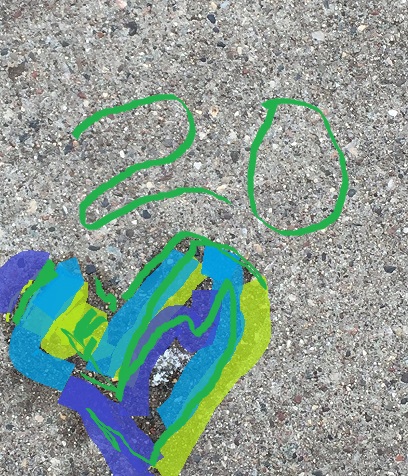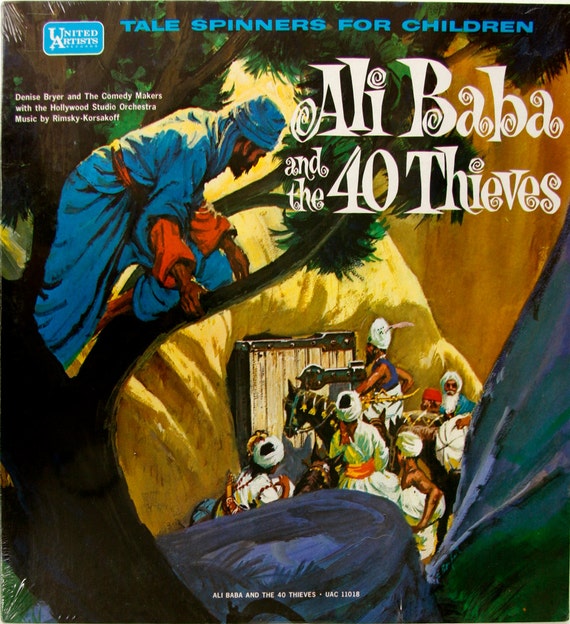
Ali Baba: A Vinyl Memory
for Nikolai Rimsky-Korsakov
I can still see that disk of ebony
incised with a spiral journey
ridden by one tiny diamond’s point
from its rim right to its very heart.
It was an old vinyl LP,
pressed when I was two or three,
and a perennial favorite.
Its highly-colored cardboard sleeve
showed Ali Baba, spying, in a tree
overhearing a magic password,
“Open Sesame,”
that caused the mountain-side to split
open so Ali Baba could steal
inside, after the thunderous thieves.
Most of all, I recall
how this deep cave was lit
by the light of jewels
hanging from trees,
a vision summoned
by a lone violin—
Scheherazade—unearthly beauty
pouring into a child’s ears
and glowing there, still,
after all these years.
Leslie Schultz
When I was very young, my mother would often play albums with stories on them in the afternoon. I still often think about four, in particular, wishing I could hear them again. Three of them were from this series: Tale Spinners for Children. A few days ago, I began thinking so strongly of the music from this one. The first four lines of this poem came. I waited until today for the rest of the poem to come clear and to share it here.
To hear an audio clip of the violin solo, just scroll down to the second one.
Which oft-heard (told, read, recorded) stories most impressed themselves upon you? I would love to hear if you’d care to share. (The other favorites in the recorded realm for me were “Beauty and the Beast” & “Aladdin and the Magic Lamp” in the Tale Spinners series, and a collection of folktales told by Beryl Berney called “All Join Hands Around the World.” I still think very often of the Japanese story she told of how there is a rabbit in the moon.)
Until tomorrow! LESLIE
Check out other participants at the NaPoWriMo Challenge 2017 home site!



One of Julia’s earliest memories of “Peter and the Wolf” as well. Her first trip to Orchestra Hall, when she was one and a half, was to see a family concert of that piece. (Minnesota Orchestra and Theatre de la Jeune Lune). And at home we often played the Leonard Bernstein-narrated tape. Such good memories! I miss those days.
Love this post, Leslie. My sister and I would spend many afternoons lying on the “TV Room” carpet listening to “Peter and the Wolf.” That and Danny Kaye as Hans Christian Andersen. Plus that Britten piece, “A Young Person’s Guide to the Orchestra” – many, many hours staring at the ceiling or out the window listening to these LPs. LOVE the photo of the album cover!
How much I am learning this April! Thank you. I am going to ponder Baba Yaga.
Leslie, “KostyanAya nogA” (I put the capital letters where the stress is) is “bony leg.” Baba Yaga has only one leg in some tales. In older tales, her mortar doesn’t fly but walks or jumps. The interesting thing about Baba Yaga is her ambiguity. She has some characteristics of a witch in the tales about about very young children who she steals (she puts them in an oven, though it never works out at the end), but she is a helper to Ivan the Fool in his search for a princess and treasure. Her main function is testing, and she is a guard between our world and the other world (that is why she is half a corpse). It is probably connected from the ancient initiation ceremonies. I always loved the idea that it is Baba Yaga who helps you to find your own way and to grow up.
Thank you for sharing this. I do know the name, “Mario Lanza,” and that he is a singer, but I do not know his music. I shall look it up directly!
I do enjoy knowing this! We recited and read lots of poetry to our Julia when she was tiny. She loved it! Emily Dickinson and Robert Frost were favorites. I think children are hard-wired to receive poetry.
What does “kostyanaya noga” translate to in English?
What a nice poem! You may enjoy it that the first stories the Russian kids remember are all poems. Even the Russian fairy tales for little kids rhyme or include the rhyming refrains that repeat. Baba Yaga was my favorite character, and her description is a poem of its own (“Baba Yaga kostyanaya noga”). In “Yaga”, the stress is on the second syllable.
Thank you for another fine poem, Leslie. I am reminded of my mother’s love for Mario Lanza, the many recordings (LPs, of course) that she had and would play.